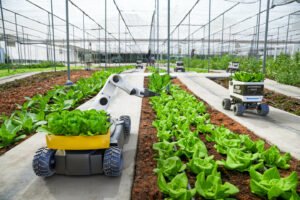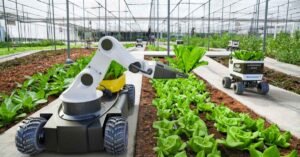A technological revolution is taking place in the rapidly changing world of agriculture, and automated greenhouse systems are at the centre of it. These high-tech installations use the latest technology to create a controlled environment in which plants can grow optimally. These systems take care of important parts of greenhouse management, such as regulating the climate, watering and supplying nutrients. They promise higher yields, better use of resources and long-term viability. This article discusses the different ways in which automated cash systems can be used. It also discusses new technologies that are changing the future of agriculture.
The Rise of Automated Cash Systems:
1. Manage the Climate and Care for the Environment
Climate control is more accurate with automated greenhouse systems. Sensors monitor temperature, humidity and light levels so the system can make immediate changes to create optimal conditions for plant growth. This level of control ensures that conditions remain the same regardless of what happens externally.
2. Automatic Plant Watering System
Automated greenhouse systems make full use of water, a precious resource. Sensors in these systems monitor how wet the dirt is and deliver water exactly where and when it is needed. This saves water and prevents the plant from absorbing too much water, which reduces the risk of diseases.
3. Transport and Fertilisation of Nutrients
Automated greenhouse systems are great for getting nutrients to your plants, which is important for their growth. By automating the nutrient delivery process, they ensure that plants receive the right combination of nutrients for proper growth. This precise approach improves nutrient absorption and reduces waste.
Benefits of Automated Cash Systems:
1. Annual Production
One of the great things about automated greenhouse systems is that they can be used to grow plants year-round. By controlling environmental factors, these systems are not dependent on seasons, allowing farms to grow crops regardless of the weather outside.
2. Increased Crop Yields
Because these methods are accurate and consistent, crop yields can be increased. Plants perform better in automated greenhouse systems because they provide the best conditions. This means that the crops are stronger and can be grown more easily compared to traditional farming methods.
3. Effective Use of Resources
In greenhouse horticulture, automation ensures better use of resources. These systems provide water and nutrients only when needed, make full use of energy for temperature control, reduce waste and make better use of resources.
Applications in Crop Management:
1. Crop-Specific Environmental Optimisation
Automation of greenhouse systems ensures that every crop has the right elements to grow well. Farmers can programme the system to create specific conditions for different crops by adjusting temperature, humidity and light levels to suit each plant’s needs.
2. Prevention and Control of Pests and Diseases
Pest and disease monitors are built into automated greenhouse systems. By identifying problems early, you can act quickly to stop them, either by using specific pesticides or by changing the environment to make it less hospitable to pests and pathogens.
3. Adaptive Growth Strategy
These systems make it easier for plants to use adaptive growth strategies. Automated greenhouse systems help plants grow optimally by changing weather factors during different growth phases. This results in a strong and healthy crop.
Sustainability and Environmental Impact:
1. Less Chemical Use
Fewer chemical inputs are used in automated greenhouse systems because they allow precise control of the environment. With the right growing conditions, as many pesticides and fertilisers are not needed, environmentally friendly and sustainable farming methods are encouraged.
2. Energy Saving Habits
Automation makes it possible to do things with less energy. These systems use as little energy as possible, which is in line with the larger goals of permaculture. For example, they use natural light where possible and make full use of heating and cooling systems.
3. Save Water
Automated greenhouse systems are great for saving water. These methods deliver water directly to the roots of plants based on real-time soil moisture data, allowing agriculture to use water more sustainably.
Questions and Things to Think About:
1. Initial Investment Costs
Setting up an automated cash system initially costs money. The long-term benefits are great, but farmers may not be able to get started. To accept it, policy support and incentives are needed.
2. Technical Knowledge
Some technical knowledge may be required to operate and manage these systems. For farmers to get the most out of automated greenhouse systems, they need easy-to-use training programmes and tools.
3. Adapt to Crop Changes
Although these systems are very accurate, they must be able to change the fact that crops are not always the same. The methods may need to be different for different plants, and the system may need to be adaptable to a variety of crops to be effective.
Prospects and New Ideas for the Future:
1. Application of Artificial Intelligence (AI)
By adding artificial intelligence, automated greenhouse systems can move in the right direction. Artificial intelligence programmes can look at large amounts of data, such as how plants grow and what the weather is like, to predict what will happen and improve the system.
2. Robots that Take Care of Plants
Within these systems, robotics could be used more broadly for plant care. Armed with sensors and tools, automated robotic arms can do things like prune, gather, and even gently move plants to help them grow better.
3. Blockchain to Keep Track of Things
Blockchain technology could make it easier to track greenhouse-grown food throughout the supply chain. Automated greenhouse systems can give people clear information about the source and quality of their food by tracking and protecting data at every step of the production process.
Conclusion:
Automated greenhouse systems are the first step in the agricultural revolution. They show us a future where accuracy, speed and environmental friendliness come together. As technology continues to change, farmers now have access to tools that push the boundaries of traditional farming. While challenges remain, automated greenhouse systems have enormous potential to make the future of global agriculture cleaner and more abundant by increasing yields, reducing environmental impact and promoting permaculture practices.
FAQs:
1. How can automated greenhouse systems help increase crop yields?
Automated greenhouse systems help increase crop yields through precise control of environmental variables. This includes optimising temperature, humidity and light levels to create ideal conditions for plant growth and maximise productivity.
2. What role does automation play in saving water in greenhouse systems?
Automation in greenhouse systems optimises water use by using sensors to evaluate soil moisture levels. The system delivers water precisely to the root zone of plants, minimising water waste and promoting sustainable water use in agriculture.
3. How can automated greenhouse systems promote sustainability and reduce the use of chemicals?
These systems promote sustainability by minimising the use of chemicals. By precisely controlling environmental conditions and nutrient supplies, automated greenhouse systems reduce reliance on pesticides and fertilisers, promoting environmentally friendly and sustainable agricultural practises.
4. What challenges do farmers face when adopting automated greenhouse systems?
Challenges include initial investment costs, the need for technical expertise and adapting the system to crop variability. Overcoming these challenges requires supportive policies, training programs and flexible systems that can adapt to different crops.
5. What innovations can we expect in the future of automated greenhouse systems?
The future will bring innovations such as integrating artificial intelligence (AI) to adjust forecasts, using robotics to perform tasks such as pruning and harvesting, and applying blockchain to improve traceability in the greenhouse produce supply chain.



